My University
The university that I am currently studying in is the Universidad Rey Juan Carlos in Fuenlabrada.
This university is one of the biggest in terms of the number of campuses and higher-education vocational colleges it has.
In total, there are four faculties at the Universidad Rey Juan Carlos and two vocational colleges:
- Faculty of Communication Sciences
- Faculty of Social and Juridical Sciences
- Faculty of Health Sciences
- Faculty of Arts
- Centre for Intelligent Information Technologies and Applications
- Centre for Innovation, Technology Transfer and Knowledge
These faculties are spread across five different campuses: Fuenlabrada, Alcorcón, Móstoles, Vicálvaro and Aranjuez.
In all of these campuses, however, there is a Faculty of Social and Juridical Sciences (which is home to the Law and Management degree) because the greatest demand exists for this.
As the Spanish will know well, but those from Madrid even more so, the majority of students finish the Bachillerato and pass the Selectividad (these two combined are equivalent to UK A-levels) to go to university and they don't have any idea of what degree they want to study. Therefore, in the end, they end up choosing Law and Management, as it has the reputation of being an easy degree and there are lots of careers paths available to them once they graduate.
But listen, it doesn't seem like a bad idea to me, but many of them don't do it because they like the degree - but then, they go to classes that don't interest them and end up annoying those who really want to study Management because they like it.
Before I continue talking about the university, it would be useful to explain a little bit about what the Selectividad consists of (it's also called the PAU, 'university admissions test'), for those who don't know what it is.

The Selectividad, or PAU, is a big final exam (in reality, many little tests), comprised of two parts.
In the first part, the students are examined in the core subjects, and in the second part, two optional subjects that they have taken for Bachillerato are examined, which are subjects that they have studied during their final two years at school.
The core subjects in the general part of the exam are:
- Spanish Language and Literature
- Philosophy or Spanish History
- One from English, French and German
- and an optional subject, according to the subject pathway that you have specialised in.
In the specific part of the exam, you have to also choose two subjects from the subject pathway studied.
Depending on the subject path, there are differing options:
- Social Sciences: Applied Mathematics to Social Sciences, Business Economics, and Geography
- Health Sciences: Biology, Physics, and Chemistry
- Technical Sciences: Technical Drawing, Mathematics and Physics
The final grade for the Selectividad (and for university entrance) will be the average of what you achieved in the two years of Bachillerato and the average of all the exams done for the Selectividad.
The grade that you achieve is out of 14, and depending on the grade, you will be able to choose one degree over another according to the minimum grades each university require for all of its degree programmes.
For Management - it's one of the degrees where the entrance grade required is relatively low - you have to get at least a 7 out of 14.
But, for those who want to study Engineering, the grade is even lower. Only a 5 out of 14 is required because there are very few people who choose to study it for their degree, and, those who do, do it because they really enjoy it.
And in the case of Joint Honours degrees or Medicine, the grade required is usually quite high, from a 10 to a 14 (for Medicine, it's a 13).
Returning to the Faculty of Social and Juridical Sciences - the original faculty is located on the Vicálvaro campus, but due to the high demand in the last few years, they have ended up adding both Law and Management degree programmes in every campus of the Universidad de Rey Juan Carlos (URJC).

Another of the Faculties of Social and Juridical Science is located on the Móstoles campus, where degrees in Management, Law and Tourism are taught. In this campus, you will find the Rector's office and all of the university secretaries.
In reality, every campus has its own student secretary offices, amongst other things, but, at the end of the day, all of the documentation that is submitted at one of these offices ends up being sent to the Móstoles campus anyway; that's where the main office that processes everything is.

The Vice-Chancellor's office is also located on this campus, which is where all the applications to the university are processed, along with any other paperwork related to the university application process. This campus is also home to the International Relations office, where students normally have to go in the event that they are selected for an Erasmus or Mundo exchange placement, or if they are an international student.
With regards to students from URJC who want to undertake an Erasmus exchange, the application must be completed online. Once you fulfil the basic criteria for consideration, the university will then look at your grade point average. Then, you will then have to select a destination university and submit personal documentation, like your DNI or a language certificate that proves you have the sufficient level required to study abroad.
In the case of wanting to go to an English-speaking university, you must have at least a B2 level of English. But, in the cases of French, German, Portuguese, and Italian-speaking universities, the minimum level required is only a B1.
After choosing your destination university, the Universidad Rey Juan Carlos gets in touch with the relevant universities to confirm the exchange placement, and once the students have been firmly accepted, they pass through to the second stage of the process, which is when all the horrific paperwork has to be submitted to formalise the mobility.
As all of you who have done an Erasmus placement will know well, and as advice for those who have been thinking about doing it, it's a very complicated process, in the sense that you have to submit a thousand and one different documents both before going, during your time at your destination university, and when you leave; you are going to spend your whole Eramus exchange doing paperwork.
The Faculty of Health Sciences is located on the Alcorcón campus. Unfortunately, it's not in the top 10 of the best Medical faculties in Spain (it's not even in that of Madrid), but it has a hospital situated just next to it, which makes placements much easier because the students don't have to travel far to do it.

The Faculty of Arts can be found on the Aranjuez campus. This campus previously belonged to one of the universities affiliated with the Universidad Complutense de Madrid, but I think that it ended up running out of money and the URJC ended up buying it.

This campus is exclusively for undergraduate students of the Arts, as, in all of the classes, there are materials for painting, making sculptures and photography. Although, around two years ago, they added Tourism and Interpretation degree programmes to this campus.
The Faculty of Communication Sciences is located on the Fuenlabrada campus. On this campus, you can find pretty much every degree programme, from Audiovisual Communication to Design, Management, Tourism, or even Fine Arts (although that degree is relatively new).
However, for Communications majors, you will only be able to find them in Fuenlabrada; it's not like Management or Tourism, dgeree prgrammes which can be found on almost any other campus at the URJC.
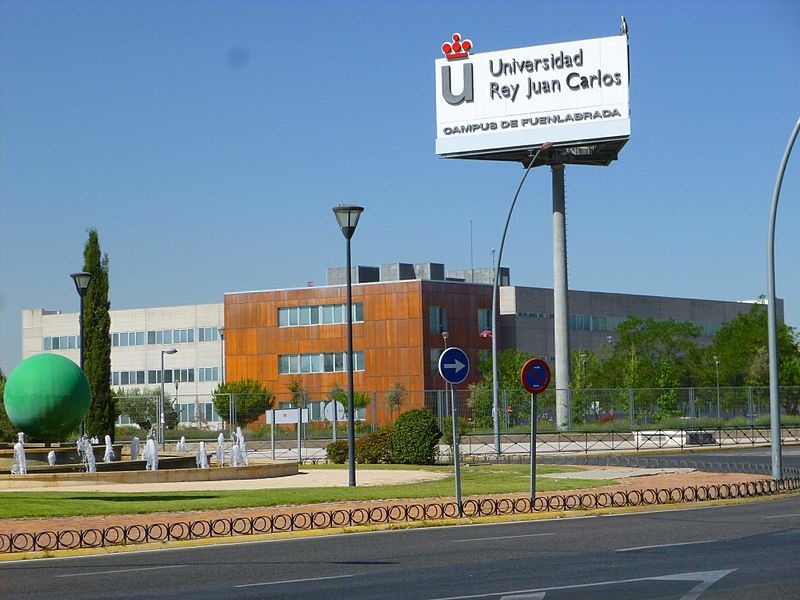
Together with the Móstoles campus, Fuenlabrada is the biggest of all the campuses that form part of the URJC and, in my opinion, it's the prettiest and is cared for the most.
And this, this is the campus where I study. Right now, I am in my final year of my undergraduate degree, which is a Joint Honours in Audiovisual Communication and Management.
This degree programme was completely new when I enrolled after finishing the Selectividad. We are the first year group to have the opportunity to study this Joint Honours prorgamme - we are usually called the "Adecau" students.
With regards to studying this Joint Honours, I have to tell you that it is all very general. With a Joint Honours, you have to squash 2 different degrees into five years of study, and in this time frame, it's basically impossible to study the whole syllabus for each module in 5 years, as each degree on its own usually takes 4 years and you study 7 modules, or more, every year.
As we were Joint Honours students, we end up taking around 10 to 12 modules per year: it's madness. And also, each module lasts for one semester. In other words, the academic year is divided into two 4-month periods; the first semester is from September to December, and the second from January to May.
Normally, the majority of universities start teaching classes in October and end in June, and the resit examinations take place in July. But, in the case of URJC, classes start in September, pretty much as soon as the holidays are ending (like at high school or college), and end in May. And, if anyone has any module pending for resit, the exam is in June. In this way, we can enjoy two whole months of summer (it's more logical like this).
As I told you before, we were the first year group for our Joint Honours programme, so, on our first day, we were all quite excited about the idea of being the first group of students to receive degrees in both Audiovisual Communication and Management at the same time.
The first day of classes for first-year students usually consists of meeting their tutor, who will be responsible for them for the duration of their degree, and going to the lecture hall where classes are normally held.
I think we went for our first day on 3rd September. We weren't the only ones there, however, there were also other first-year students there for the presentation.
Now I will explain a little bit about how to get to the Fuenlabrada Campus.
To get to the university on public transport, you would normally take the metro (although you can also take the bus if you live in close vicinity to the campus), specifically the 'Metro Sur', getting off at the 'Hospital de Fuenlabrada' stop.

You have to pay a lot of attention to the name of the stops because there is one called 'Universidad Rey Juan Carlos', but this is for the Móstoles campus, not Fuenlabrada.
The 'Hospital de Fuenlabrada' stop has two exits to street level. To get to the first, you have to turn left to get to the escalator, where you will ultimately end up in front of the Hospital de Fuenlabrada (where the stop gets its name from). And for the other exit, if you continue straight on, you will see, upon exiting the doors, that you are just in front of the entrance to the Fuenlabrada campus.
Once inside, you will notice that the campus has a lot of spacious, green areas between the teaching buildings - this is where the lecture halls that house various classes are located - and an enormous library.
After passing the main entrance after exiting the metro, there is a little wooden bridge over a really pretty, and well cared for, lawn. On either side of the bridge, there are usually rose bushes and evergreen oak, surrounded by a lot of grass.
After crossing the bridge, on the left hand side, you will find the first teaching building with a laboratory next to it. Every teaching building has another building next to it which house laboratories, but they aren't the typical scientific laboratories where experiments are carried out, instead they are: laboratories with television studios for Communication practicals; computer rooms for IT practicals; and, sculpturing and painting rooms for Arts students, etc.
For example, in Laboratory I, there is a television studio, and computers installed with the software, Avid, for video editing, and you can also borrow reflex cameras, provided that you leave your student ID or DNI as a 'deposit'.

On the ground floor of the building, there is also a radio room with five smaller rooms within it for Radio majors, where, for their practicals, the students must record their own radio programme. Although, there also students who do this as a hobby and are radio presenters for the university (mind you, they don't earn anything from doing it).

Each teaching building and lab building is comprised of two, spacious floors, except from Building III and Lab III, which are the biggest and each have four floors.
Past the bridge on the left-hand side is Building I, and straight in front of you, on the right-hand side, is the Departmental Building; a building with a very original wooden facade.

The Departmental Building is exclusively for the use of professors, where you can find their corresponding offices in the case of wanting to have a tutorial with them, both before or after class.
If we carry on on the left-hand side, past Building I, we have the option to turn right and carry straight on until reaching Building III, or continuing straight on, passing Building I to get to Building II.
Carrying straight on along the left-hand side, after crossing the bridge, you will first find Lab II and, next to it, joined together by a little concrete roof, Building II.

It was in that building, on the ground floor, where we took classes during the first three years of our degree.
We were quite a large cohort, some 80 or more if I remember correctly, and it was in Building II where there were more spacious lecture halls that have more seats.
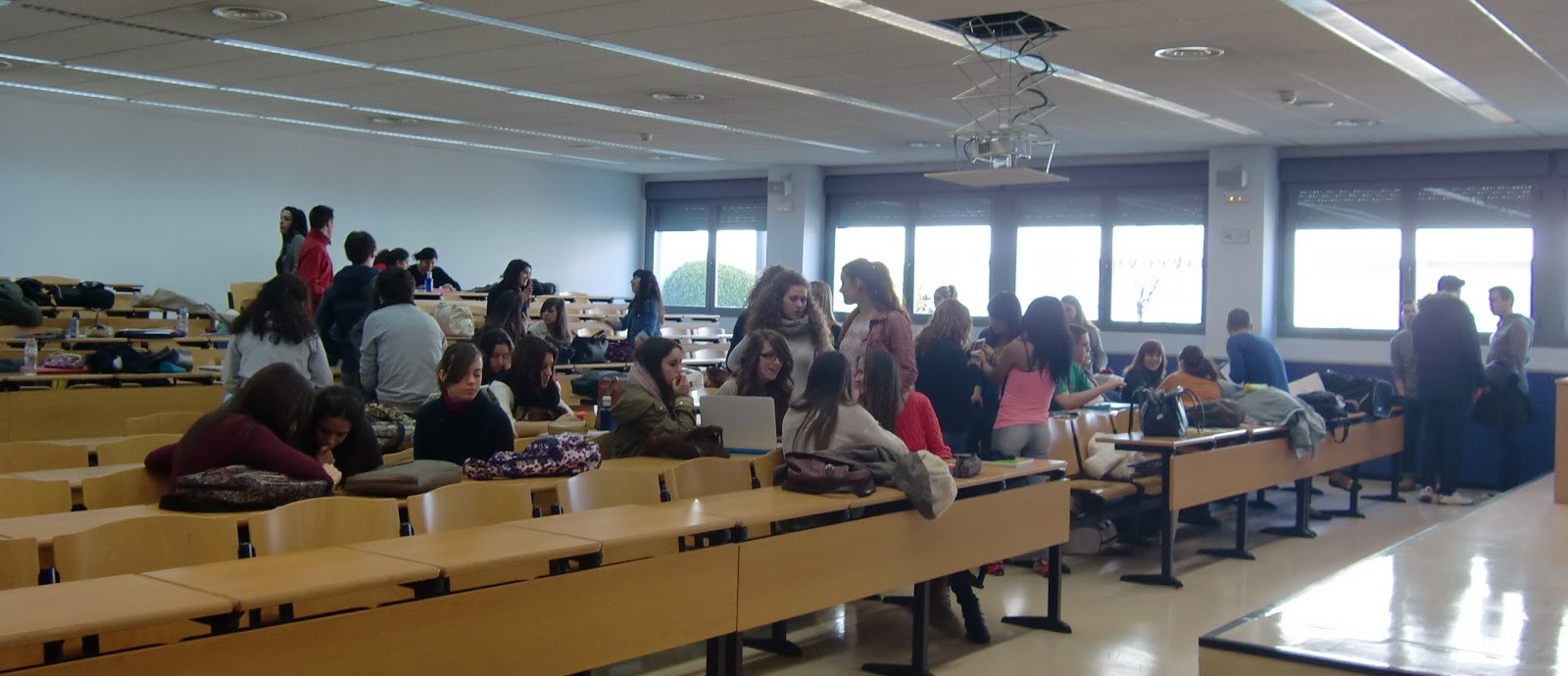
But, for fourth and fifth year, they changed our lecture halls to the second floor of Building I because the number of people on our course had reduced drastically to almost half.
Many of them had ended up dropping out or had decided to change to a different course, like Communications, for example, because the first year of "Adecau" had disappointed them and it didn't match their initial expectations.
I have to admit that I was also at the point of changing my degree and just doing Communications because I didn't really like Management that much (despite getting a 9 out of 10 in Economics in the Selectividad). But, I thought about it more and decided to continue, in spite of this, because I knew that, five years down the line, I would have 2 degrees, and I would have the option of two different career paths, so the effort seemed to be worth it.
Continuing with the tour, it's also in Building II where Modern Languages classes are taught, where students usually learn English or French.
Next to Building II, in Lab II, you can find the Modern Languages departmental office on the ground floor. On the first floor of the building, you will find the rooms with computers for IT classes. In second and fourth year, you can choose to add a minor in Modern Languages and a specialism in IT, respectively.
It's compulsory for all students at URJC (Universidad Rey Juan Carlos) to study these two modules in order to graduate.
For the IT specialism, you have to choose between different types of Office software:
- Microsoft Word
- Microsoft PowerPoint
- Microsoft Excel.
The majority of students who study within the Faculty of Social and Juridical Sciences end up choosing Excel, whereas Journalism or Tourism students gravitate more towards Word, and Communication students usually choose PowerPoint (it makes sense though, right? ).
In my case, as I already knew how to work Excel and Word quite well, I opted for PowerPoint, and, to tell you the truth, it was a good choice because I learnt a lot of things that I didn't previously know was possible to do hrough this software.
Once you pass the module (it lasts for one semester and is 100% practical work), you receive the official 'expert' diploma in the module that you chose, so I am now an expert in PowerPoint, haha.
The same thing happens with Modern Languages. You can choose between:
- English
- French
- Italian
- Portuguese
- German
Once you have chosen the language you want to study, you have to pass an online theory exam to see what your language level is and to allocate you to a class which best matches the grade you achieved on said exam.
To pass the module, you have to pass with an average of a 5 out of 10 in the three exams that you will take throughout the semester (these exams are similar to the final exam) and, finally, you will have to pass the final exam, which is the official TOEIC (Test of English for International Communication) exam.
This exam is also important if you decide that you want to do an Erasmus exchange.
In order to be able to apply for a place and fulfil the criteria for phase one of the application, you must prove, with an official diploma, that you have a B1 level in any language, except for English, for which you must prove that you have a B2 level.
It's like this for English because, normally, the universities that accept students that speak English, the language level is quite a bit higher, therefore a B1 alone is insufficient.
To prove that you have achieved this level or have successfully passed the TOEIC, you have to have more than 760 points (in the case of English), or, equally, have successfully completed the DELF exam for French, or the Cambridge exam for English; or do an exam designed to award you with a specific language level upon successful completion for those who want to apply for an Erasmus exchange.
For my first Erasmus placement in France, it was sufficient for me to show my DELF diploma, that I had at B2 level, but for my Erasmus internship in Germany, they didn't ask me for any diploma, as the business took it upon itself to verify whether I had the minimum level to be able to work in both English and French.
However, next year, I will take a couple of modules that I intentionally didn't study last year to be able to study in the United States for a semester, thanks to a Mundo grant.
This grant allows students to be able to study in any university in the world that has an exchange agreement in place with URJC outside of Europe.
And the best part of all is URJC takes care of all the application fees and materials required to attend classes, like books and photocopies; it would be a considerable expense if it were to come out of your own pocket.
Given that my TOEIC diploma was no longer valid, due to having taken the exam three years ago, I had to do the specific-level exam that I mentioned earlier, which was exactly the same as the official TEOIC exam.
For this exam, they don't give you a grade, they simply tell you if you have passed or not, and that's it. If you did pass, you are put through to the second phase of the application, which is the allocation of places and choosing destination universities.
Well, we will now finally get back to our tour of the Fuenlabrada campus.
So, past Building II and Lab II, to our left there is a circular building - you will never know what it is. It seems to be a supplies building, or something like that, but, anyway, you can't go near it because it has a fence around it.

There is a rumour going around that it is actually a spaceship where there are aliens who study the behaviour of the human race. It's nonsense, but due to the incognito nature of this building, anyone can believe what they want to about it.
Continuing straight on, following the slight curve, you will see the restaurant area to the left, where there is:
- a cafeteria
- a canteen
- a branch of Santander bank
- a bookshop
- a copy shop
- the student ID office.
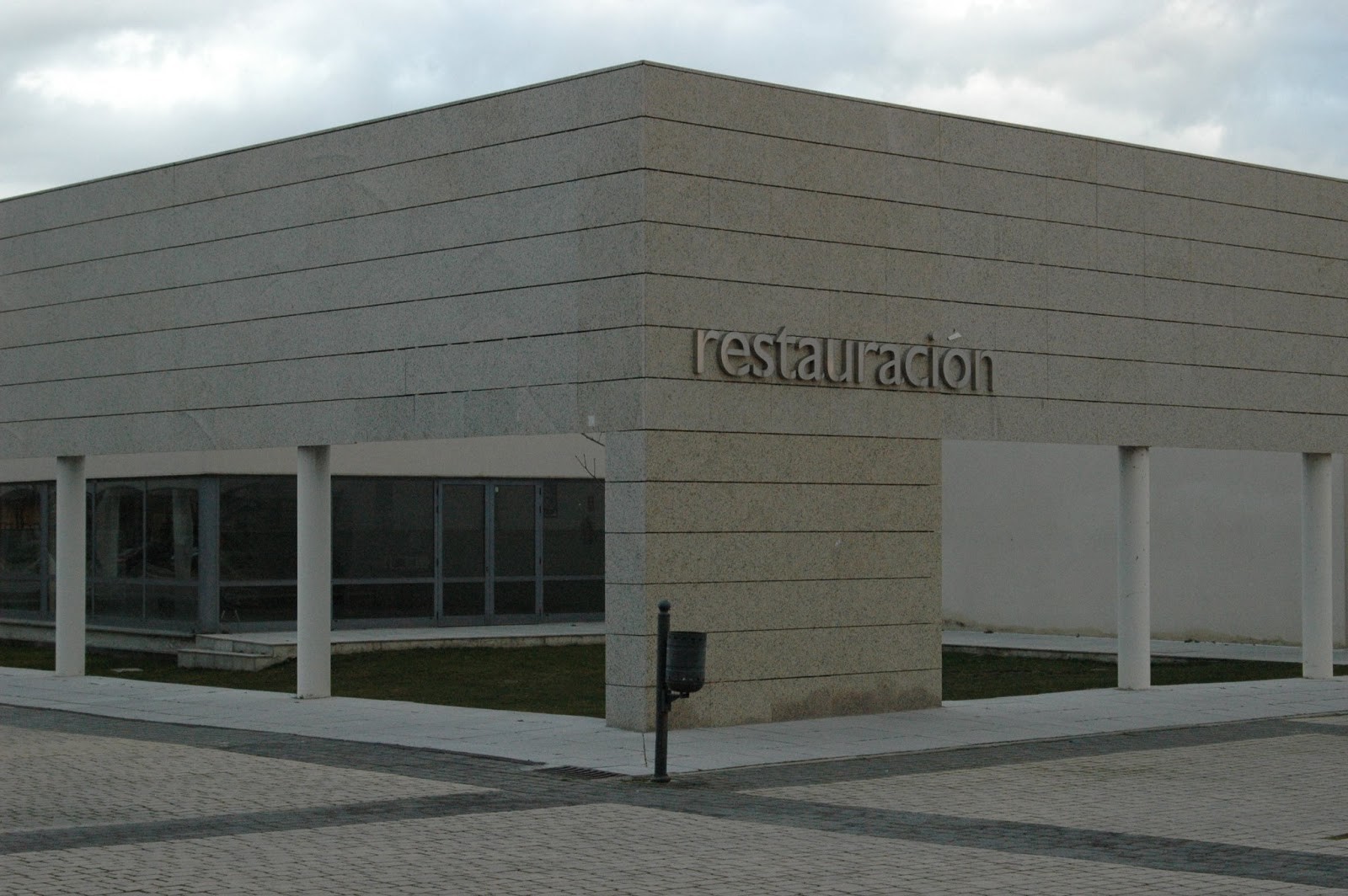
All of the buildings mentioned form a kind of squared U shape and, in the centre, there is a lawn where students often lie down and take a nap when it's good weather.
The cafeteria is a little bit small considering how big the campus is, and it fills up really quickly during class changeovers. However, the canteen located just next to it is enormous.
In the entrance-way, there are several tables where people who bring food from home sit to eat, as there are also microwaves where they can heat up their food. Beyond the microwave station, you will see the rest of the canteen and a buffet bar, where you can buy the menu of the day.
I have never eaten the food from the canteen because I always bring something from home, but I have taken a quick peek on various occasions and it doesn't look very good to be honest... at least the prices are fairly reasonable.
I have, however, on several occasions, bought food from the cafeteria.

There are little sandwiches with tortilla, Iberian ham or vegetables, which, when I started my degree, used to cost 70 cents, but now they cost at least 1€, maybe more. They also sell huge chocolate palmiers for 80 cents (well, they cost that much in my day, now I am not sure how much they will be).
The cafeteria and the canteen are located right at the end of this U-shaped area. On one side, there is the photocopying room, which is quite big, but basically nobody goes there because it's expensive to both print and make copies. Besides, just next to the exit of the metro, there is a much cheaper copy shop.
Next to the on-campus photocopying room, there is a branch of Santander bank, which is where all the international students who come to study at URJC normally go to open their bank accounts. I also ended up opening my account there because I thought it would be easier for me, with it being right next to my classes, to submit any physical documentation if needed or sort any issues if they arose.
On the other side of this U, you will find the university bookshop, where they sell all the books that your professors request you to buy for their classes.
Following our route around campus, before arriving at the enormous library, we can see the university sports centre in the background, where the official university teams train, like the basketball team, futsal and football teams, and tennis and paddle tennis teams, amongst others.

Students can also enrol onto sports courses and gain academic ETC credits towards their degree.
As well as being able to play sports, there is also a large gym for those students who want to weight train, and they will also be able to earn free choice ETC credits.
As a URJC student, the monthly cost to use the sports facilities is somewhere in the region between 20€ and 25€, depending on the sport chosen.
The next thing that we come to is the immense university library, and behind it, there are huge grassy areas with trees and rose bushes: a perfect place to sit and study on sunny days or simply to talk about how you have found an exam to be.


And, it's in these beautiful gardens where one of the most important campus parties is held: the 'sangraida'.

One thing that, at best, those of you who aren't Spanish and have studied or taken holidays in Spain (because surely you will have been to one of these parties), is that the huge parties that take place in Spain with a ridiculous amount of people, normally at the university, are called a botellón.
The idea of a botellón is to stay on campus and bring lots of alcohol with you to get drunk with, and everyone goes to get to know other people.
The botellón at the Fuenlabrada campus of URJC, normally takes place on the grassy area behind the library, although, in general, people usually spread out around the whole of the campus because it's enormous and it makes sense given the number of people who attend.
The party takes place every year in the middle of September, and people normally take sangría to drink, so that's where the name, 'sangriada', comes from.
I only went to the party once to see what it was like (in my second year) and, urgh, well it wasn't exactly as big of a deal as everyone was making it out to be. People were simply sat in circles on the lawn drinking until they could no longer see straight, before they started doing stupid things that they would later regret having done.
But, in short, if you are an Erasmus student and you study at this campus, you won't lose anything by going - it's likely that you'll meet more people this way.
The worst thing about this botellón actually comes during the following day. People are honestly really thoughtless when it comes to the environment: instead of taking their rubbish with them when the party ends, they leave all their bags and bottles littered everywhere without a care in the world.
I remember that the day after the botellón in my first year, the whole campus was just full of rubbish... there were even half-finished bottles of sangría and half-eaten sandwiches carelessly discarded on the floor. It was a huge shame.
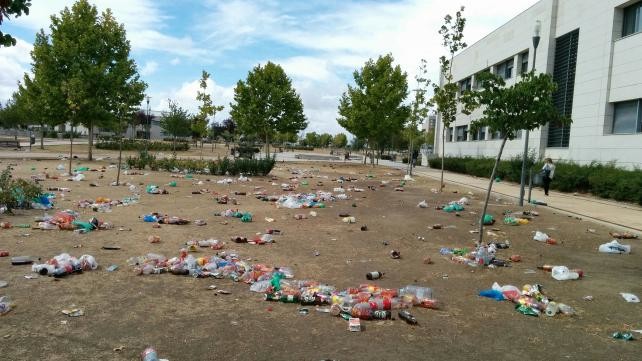
Anyway, going back to the library, as I said earlier, it's really quite large: the building itself consists of four floors, including the basement.
Taking the stairs on the right by the ground floor entrance, there is a soundproof glass room exclusively for group work. There, students meet up to discuss work that they have to do together for their classes. To be able to reserve a table in there, you have to leave your university ID card at reception as a "deposit", so to speak, but it's preferable to reserve them in advance because this room fills up very quickly, especially after classes at around 3pm.

After this, you will find the computers - there are around ten rows of tables that have computers on either side.

Continuing on, to get into the room where all the books are found, you enter through a door on the right, behind which there is a spiral staircase leading up to the other floors.

All the books are on the first floor, not those that you can read for pleasure, however, but, in fact, ones for teaching and research... in other words, you aren't going to find Harry Potter or The Hobbit there.
With regards to the room that houses the books, it's quite big, although I don't think it's big enough given the quantity of books there are. The library itself is big in terms of all the study spaces it has for the students, both for individuals and groups.
The second floor is exclusively for studying purposes only.
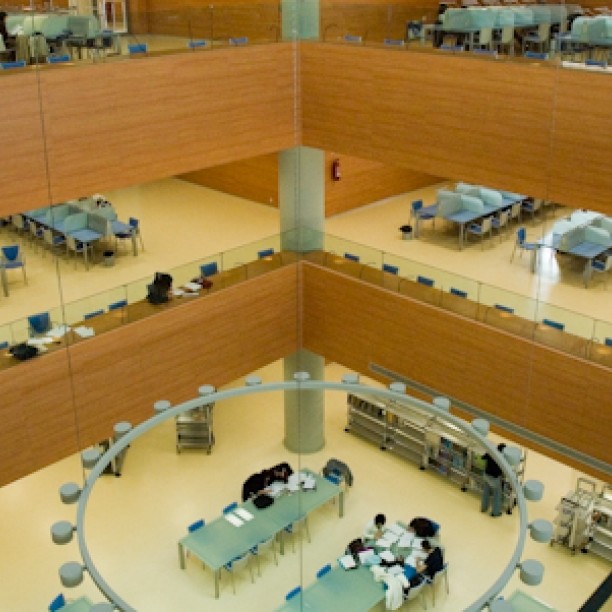
On one side, there is a big room with individual tables for private study, and to be able to sit there, you have to be remain in absolute silence or they will end up kicking you out. In this room, there is not a single book, just tables for you to study at.
In the room just off to the side, there is another soundproof room for group work, and within this room itself, there are two smaller meeting rooms.
On this same floor, there is a chill-out area with palm trees and benches for you to sit down comfortably at - it's all really pretty.
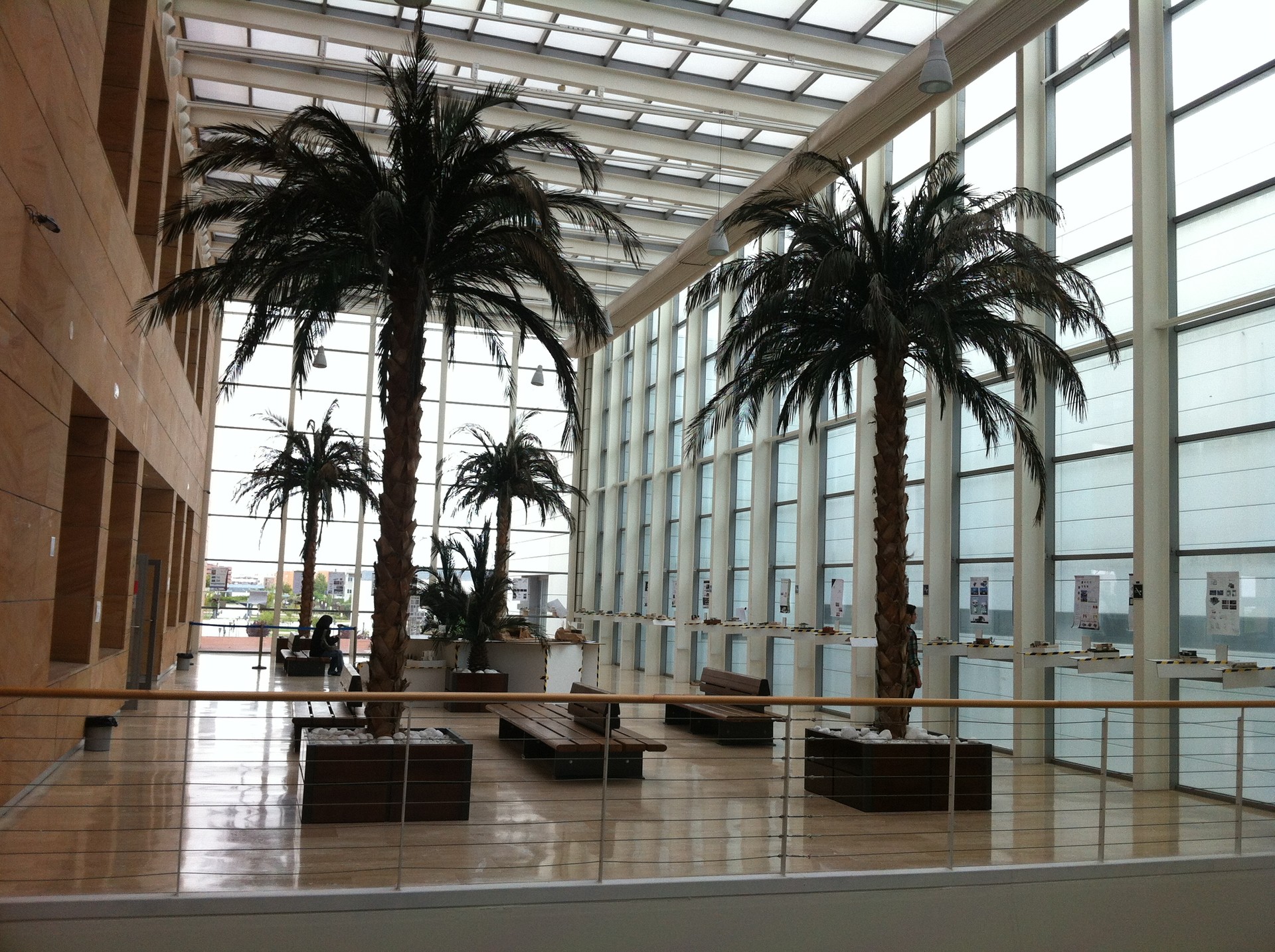
And finally, it's on the fourth floor where you will find a room full of DVDs for the CAU students, as we have to watch a lot of films on a daily basis for our classes.

In reality, anyone can request to check out both the DVDs and VHS - the only requirement is that you leave your university card in exchange.
The fourth floor also has a room that's exclusively for private study, just like that of the third floor. The only difference, however, is that instead of having a group study room, it has a viewing room and DVDs available to rent.
As you can see in the previous image, there are red doors at the back of the room. There are five of them in total, and there are for watching DVDs (films or TV series), for watching television, or even for playing on the PlayStation. A bit outdated, I know.
To be able to play the PlayStation (I think it's actually a PlayStation 2), the only thing that you have to do is bring the controllers from home because they don't have any there.
Finally, in the rear part of the library, there are also offices where the International Relations normally work from, but they are quite inept and they will always tell you to go directly to the Vice Chancellor's Office in Móstoles...
After leaving the library (there is, of course, a lift for both the disabled and the lazy... ), these are the views that you are going to be met with once having walked out of the doors.

On the left hand side, we will find Lab III, where there are dedicated rooms for Art and Architecture students, in addition to several TV viewing rooms for Communications students, and Building III.
These two buildings are the largest, apart from the library, of course.
It's in Building III where the January, May and June round of exams are normally done.
The white-coloured building that you can see to the left is Building II (where my first ever class was) and, behind this, is its corresponding laboratory.
To the left of this image, although it's a bit further out, is the Management Office, where the Secretary and Student Records can be found.

At the start of every academic year during the first few weeks of classes, that building is completely full of people because the university is fairly chilled out when it comes to processing class enrolments and students always end up going there because they have to submit one kind of documentation or another.
Well, there's little left to say really. In my opinion, it's a fairly big and impressive campus, well-equipped with facilities for all students, but especially for those who require practical space, like Communications, Architecture and Fine Arts students.
Photo gallery
Content available in other languages
- Español: Mi Universidad
- Italiano: La mia università
Rate and comment about this place!
Do you know Universidad Rey Juan Carlos? Share your opinion about this place.











































